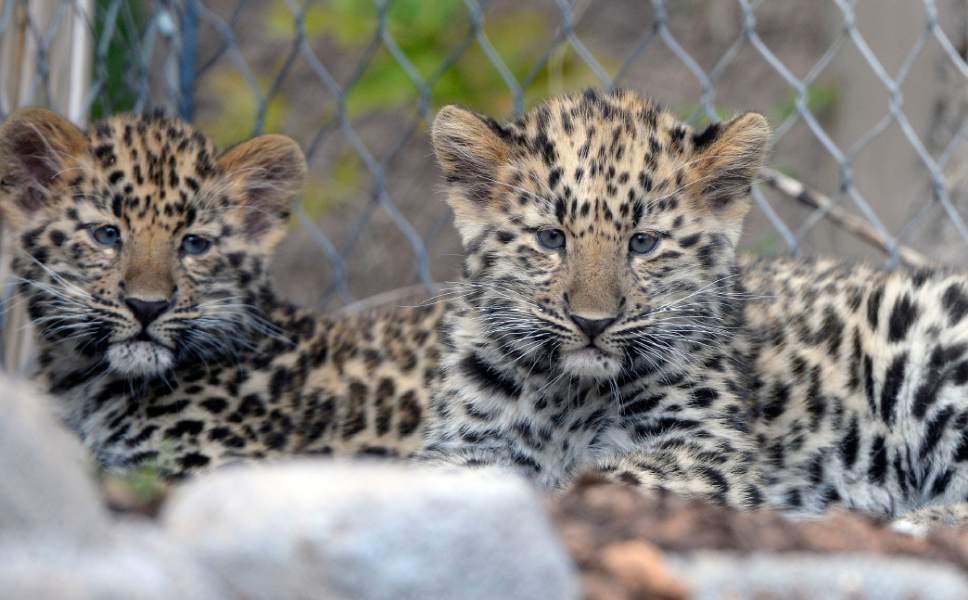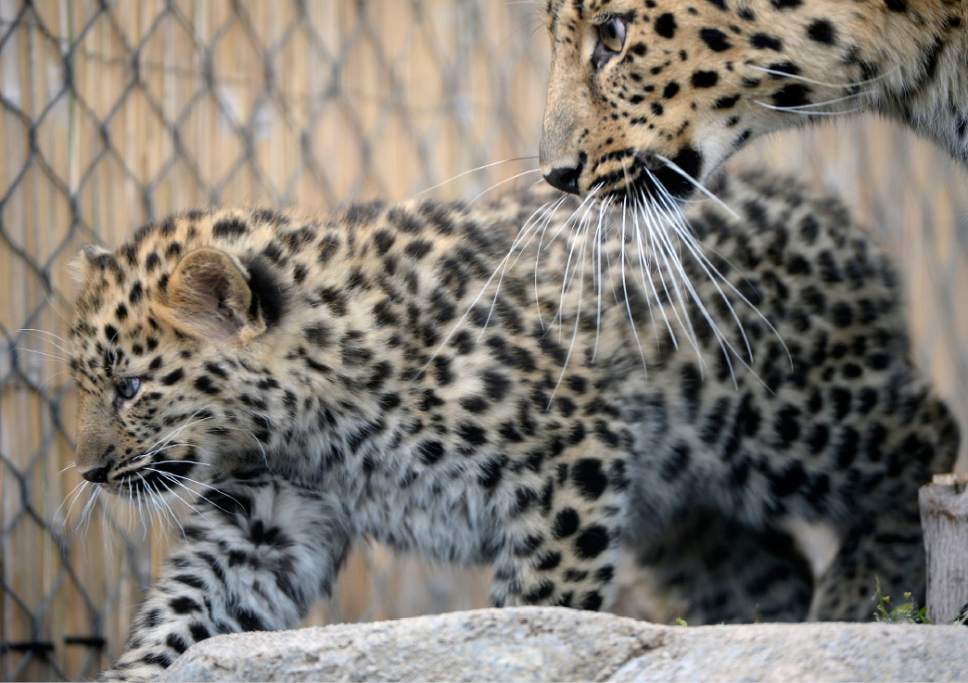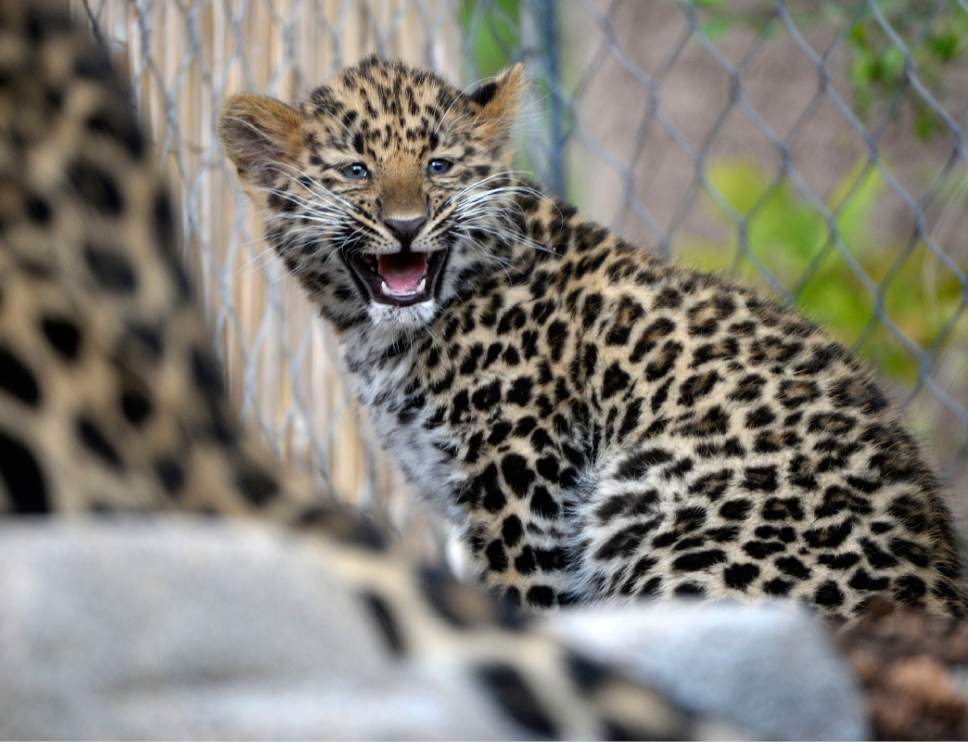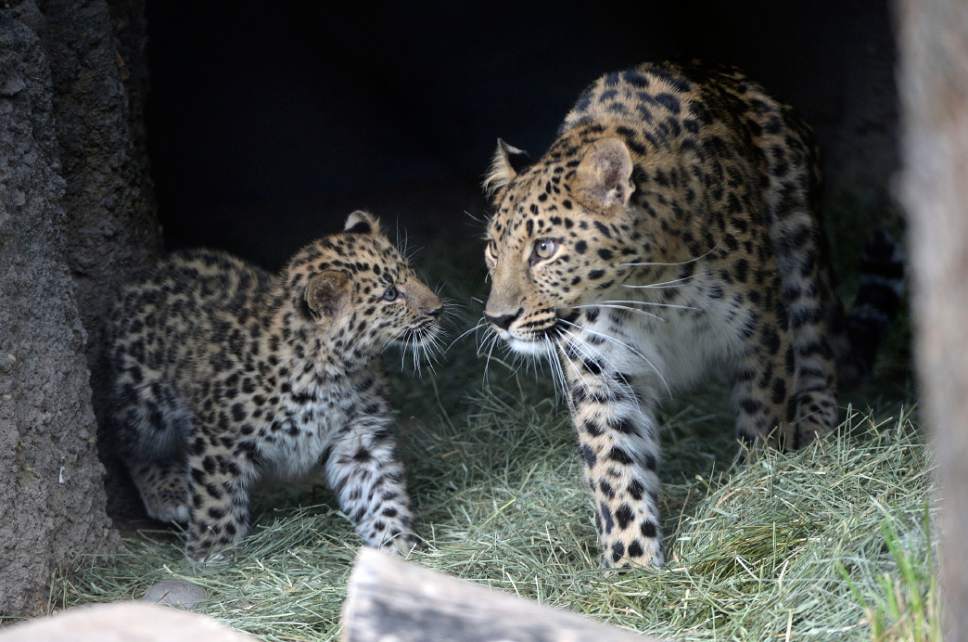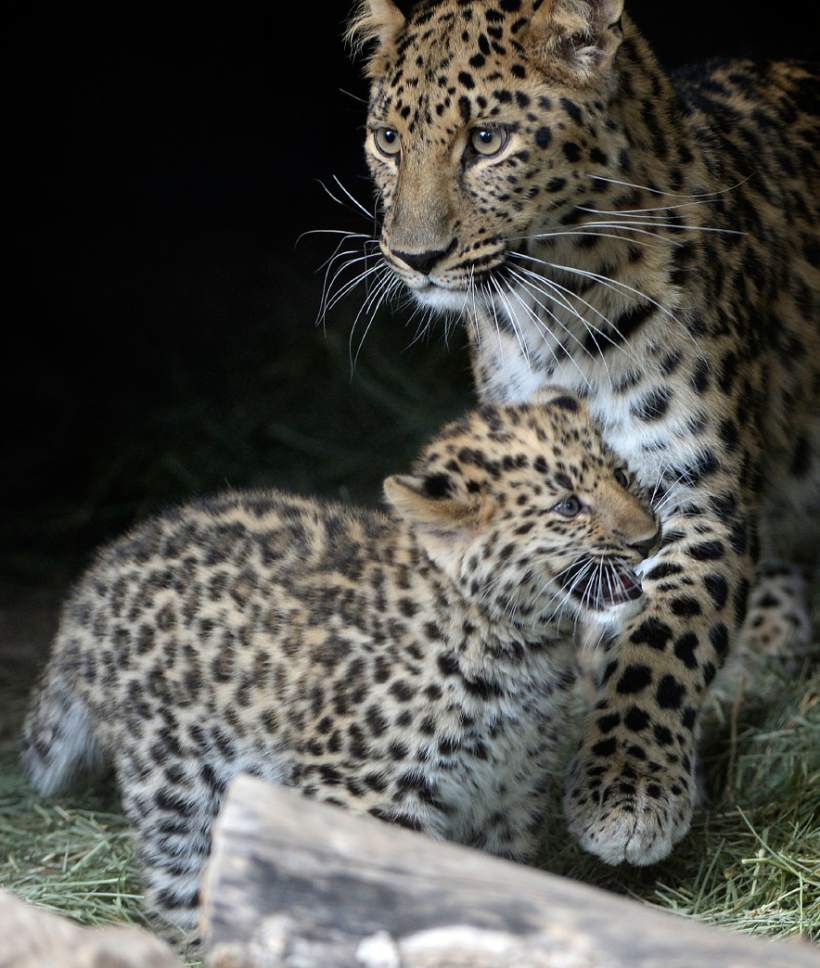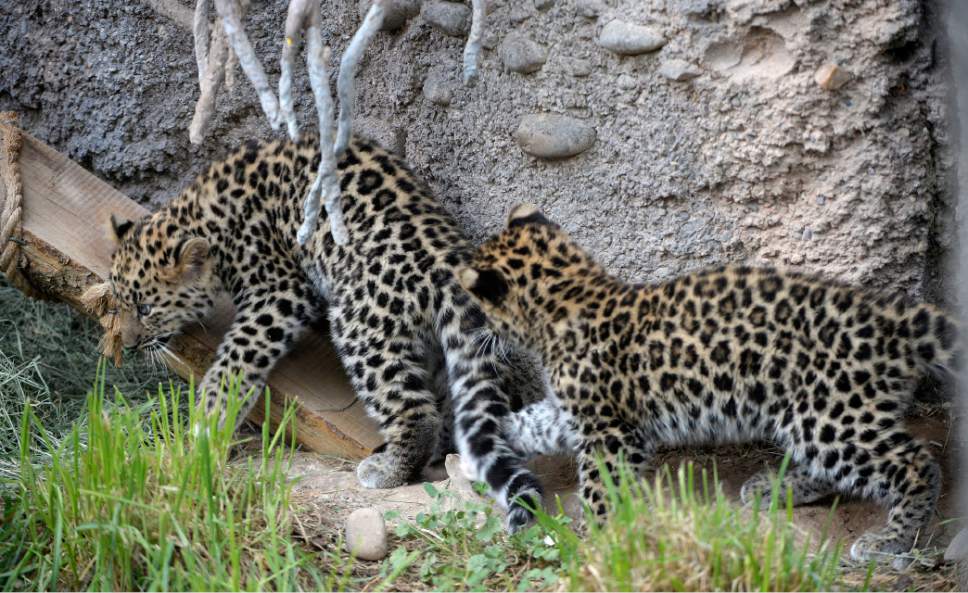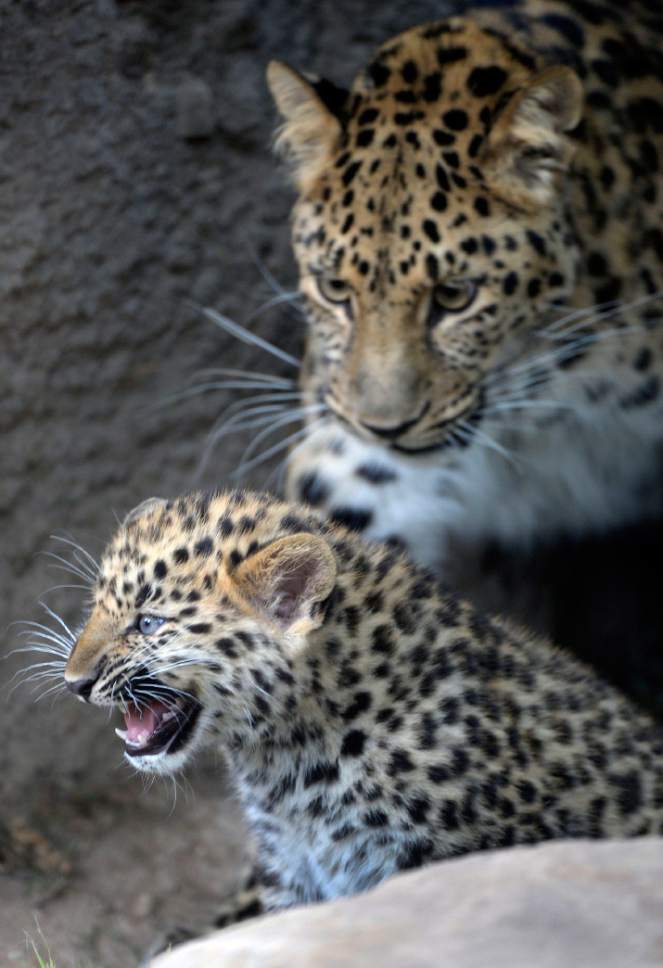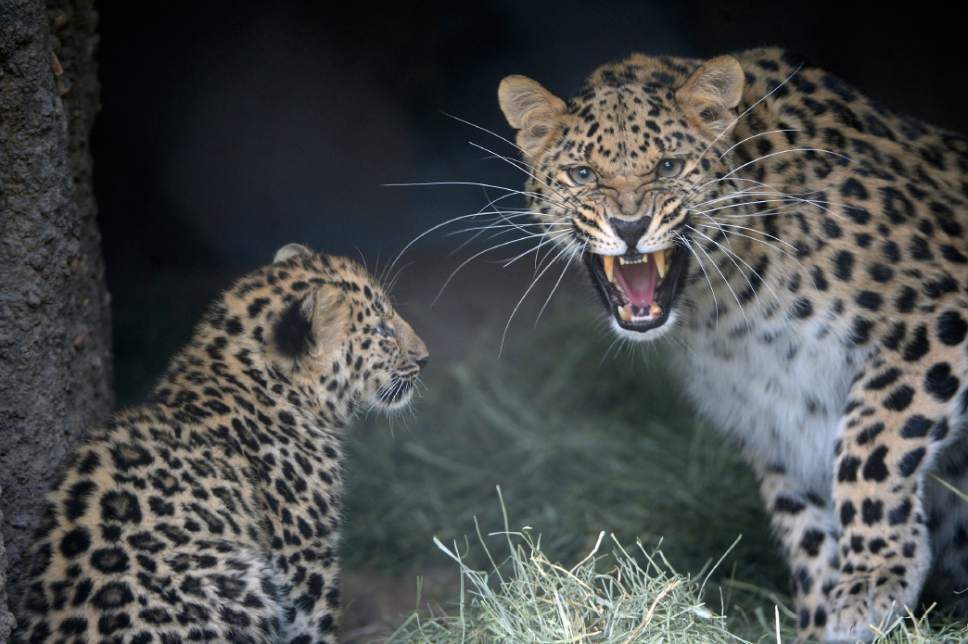Al Hartmann | The Salt Lake Tribune
Roman, left, and Raferty, two critically endangered Amur Leopard cubs born at Hogle Zoo Feb.
Al Hartmann | The Salt Lake Tribune
Raferty, left, and Roman, two critically endangered Amur Leopard cubs born at Hogle Zoo Feb.
Al Hartmann | The Salt Lake Tribune
Rafferty, one of two critically endangered Amur Leopard cubs born Feb. 17 at Utah's Hogle Zo
Al Hartmann | The Salt Lake Tribune
Roman, left, and Raferty, two critically endangered Amur Leopard cubs born at Hogle Zoo Feb.
Al Hartmann | The Salt Lake Tribune
Rafferty, one of two critically endangered Amur Leopard cubs born Feb. 17 at Utah's Hogle Zo
Al Hartmann | The Salt Lake Tribune
Rafferty, one of two critically endangered Amur Leopard cubs born Feb. 17 at Utah's Hogle Zo
Al Hartmann | The Salt Lake Tribune
Roman, one of two critically endangered Amur Leopard cubs born Feb, 17 at Utah's Hogle Zoo,
Al Hartmann | The Salt Lake Tribune
Roman, left, and Raferty two critically endangered Amur Leopard cubs born at Hogle Zoo Feb.
Al Hartmann | The Salt Lake Tribune
Rafferty, one of two critically endangered Amur Leopard cubs born Feb. 17 at Utah's Hogle Zo
Al Hartmann | The Salt Lake Tribune
Rafferty, one of two critically endangered Amur Leopard cubs born Feb. 17 at Utah's Hogle Zo
Al Hartmann | The Salt Lake Tribune
Rafferty, one of two critically endangered Amur Leopard cubs bornFeb. 17 at Utah's Hogle Zoo
Al Hartmann | The Salt Lake Tribune
Rafferty, left, and Roman two critically endangered Amur Leopard cubs born Feb. 17 at Utah's
Al Hartmann | The Salt Lake Tribune
Rafferty, left, and Roman, two critically endangered Amur Leopard cubs born Feb. 17 at Utah
Al Hartmann | The Salt Lake Tribune
Rafferty, one of two critically endangered Amur Leopard cubs born Feb. 17 at Utah's Hogle Zo
Al Hartmann | The Salt Lake Tribune
Rafferty, one of two critically endangered Amur Leopard cubs born Feb. 17 at Utah's Hogle Zo
Al Hartmann | The Salt Lake Tribune
Roman, left, and Raferty, two critically endangered Amur Leopard cubs born at Hogle Zoo Feb. 17 take a rest after playing together and exploring their new outdoor home on the first day out in public Thursday May 18. Experts estimate only 60 leopards remain in the wild.
Rafrerty and Roman have been bonding with mom, Zeya, and learning the basics of climbing and jumping. Zeya is doing a great job - she's nurturing and fiercely protective of her two cubs.
Al Hartmann | The Salt Lake Tribune
Raferty, left, and Roman, two critically endangered Amur Leopard cubs born at Hogle Zoo Feb. 17 play together and explore their new outdoor home on the first day out in public Thursday May 18. Experts estimate only 60 leopards remain in the wild.
Rafrerty and his brother Roman have been bonding with mom, Zeya, and learning the basics of climbing and jumping. Zeya is doing a great job - she's nurturing and fiercely protective of her two cubs.
Al Hartmann | The Salt Lake Tribune
Rafferty, one of two critically endangered Amur Leopard cubs born Feb. 17 at Utah's Hogle Zoo, stays close to his mother, Zeya, on his first day out in public Thursday. Experts estimate only 60 leopards remain in the wild.
Rafrerty and his brother, Roman, have been bonding with mom and learning the basics of climbing and jumping. Zeya is doing a great job - she's nurturing and fiercely protective of her two cubs.
Al Hartmann | The Salt Lake Tribune
Roman, left, and Raferty, two critically endangered Amur Leopard cubs born at Hogle Zoo Feb. 17 play together and explore their new outdoor home on the first day out in public Thursday May 18. Experts estimate only 60 leopards remain in the wild.
Rafrerty and his brother Roman have been bonding with mom, Zeya, and learning the basics of climbing and jumping. Zeya is doing a great job - she's nurturing and fiercely protective of her two cubs.
Al Hartmann | The Salt Lake Tribune
Rafferty, one of two critically endangered Amur Leopard cubs born Feb. 17 at Utah's Hogle Zoo, stays close to his mother, Zeya, on his first day out in public Thursday. Experts estimate only 60 leopards remain in the wild.
Rafferty and his brother, Roman, have been bonding with mom and learning the basics of climbing and jumping. Zeya is doing a great job - she's nurturing and fiercely protective of her two cubs.
Al Hartmann | The Salt Lake Tribune
Rafferty, one of two critically endangered Amur Leopard cubs born Feb. 17 at Utah's Hogle Zoo Feb. 17 stays close to his mother, Zeya, on his first day out in public Thursday. Experts estimate only 60 Amur leopards remain in the wild.
Rafferty and his brother, Roman, have been bonding with mom, Zeya, and learning the basics of climbing and jumping. Zeya is doing a great job - she's nurturing and fiercely protective of her two cubs.
Al Hartmann | The Salt Lake Tribune
Roman, one of two critically endangered Amur Leopard cubs born Feb, 17 at Utah's Hogle Zoo, stays close to his mother Zeya on his first day out in public Thursday. Experts estimate only 60 leopards remain in the wild.
Roman and his brother, Rafferty, have been bonding with mom, Zeya, and learning the basics of climbing and jumping. Zeya is doing a great job - she's nurturing and fiercely protective of her two cubs.
Al Hartmann | The Salt Lake Tribune
Roman, left, and Raferty two critically endangered Amur Leopard cubs born at Hogle Zoo Feb. 17 stay close to their mother Zeya exploring their new outdoor home on the first day out in public Thursday May 18. Experts estimate only 60 leopards remain in the wild.
Rafrerty and Roman have been bonding with mom, Zeya, and learning the basics of climbing and jumping. Zeya is doing a great job - she's nurturing and fiercely protective of her two cubs.
Al Hartmann | The Salt Lake Tribune
Rafferty, one of two critically endangered Amur Leopard cubs born Feb. 17 at Utah's Hogle Zoo, leaves his den with mother, Zeya, on his first day out in public Thursday. Experts estimate only 60 leopards remain in the wild.
Rafferty and his brother, Roman, have been bonding with mom, Zeya, and learning the basics of climbing and jumping. Zeya is doing a great job - she's nurturing and fiercely protective of her two cubs.
Al Hartmann | The Salt Lake Tribune
Rafferty, one of two critically endangered Amur Leopard cubs born Feb. 17 at Utah's Hogle Zoo,7 stays close to his mother Zeya on his first day out in public Thursday. Experts estimate only 60 leopards remain in the wild.
Rafferty and his brother, Roman, have been bonding with mom, Zeya, and learning the basics of climbing and jumping. Zeya is doing a great job - she's nurturing and fiercely protective of her two cubs.
Al Hartmann | The Salt Lake Tribune
Rafferty, one of two critically endangered Amur Leopard cubs bornFeb. 17 at Utah's Hogle Zoo, stays close to his mother, Zeya, on his first day out in public Thursday. Experts estimate only 60 leopards remain in the wild.
Rafferty and his brother, Roman, have been bonding with mom, Zeya, and learning the basics of climbing and jumping. Zeya is doing a great job - she's nurturing and fiercely protective of her two cubs.
Al Hartmann | The Salt Lake Tribune
Rafferty, left, and Roman two critically endangered Amur Leopard cubs born Feb. 17 at Utah's Hogle Zoo, play together and explore their new outdoor home on the first day out in public Thursday. Experts estimate only 60 leopards remain in the wild.
Rafferty and Roman have been bonding with mom, Zeya, and learning the basics of climbing and jumping. Zeya is doing a great job - she's nurturing and fiercely protective of her two cubs.
Al Hartmann | The Salt Lake Tribune
Rafferty, left, and Roman, two critically endangered Amur Leopard cubs born Feb. 17 at Utah's Hogle Zoo, play together and explore their new outdoor home on the first day out in public Thursday. Experts estimate only 60 leopards remain in the wild.
Rafferty and Roman have been bonding with mom, Zeya, and learning the basics of climbing and jumping. Zeya is doing a great job - she's nurturing and fiercely protective of her two cubs.
Al Hartmann | The Salt Lake Tribune
Rafferty, one of two critically endangered Amur Leopard cubs born Feb. 17 at Utah's Hogle Zoo, stays close to his mother, Zeya, on the cub's first day out in public. Experts estimate only 60 leopards remain in the wild.
Rafferty and his brother, Roman, have been bonding with mom, Zeya, and learning the basics of climbing and jumping. Zeya is doing a great job - she's nurturing and fiercely protective of her two cubs.
Al Hartmann | The Salt Lake Tribune
Rafferty, one of two critically endangered Amur Leopard cubs born Feb. 17 at Utah's Hogle Zoo, stays close to his mother, Zeya, on his first day out in public. Experts estimate only 60 leopards remain in the wild.
Rafferty and his brother, Roman have been bonding with mom, Zeya, and learning the basics of climbing and jumping. Zeya is doing a great job - she's nurturing and fiercely protective of her two cubs.


